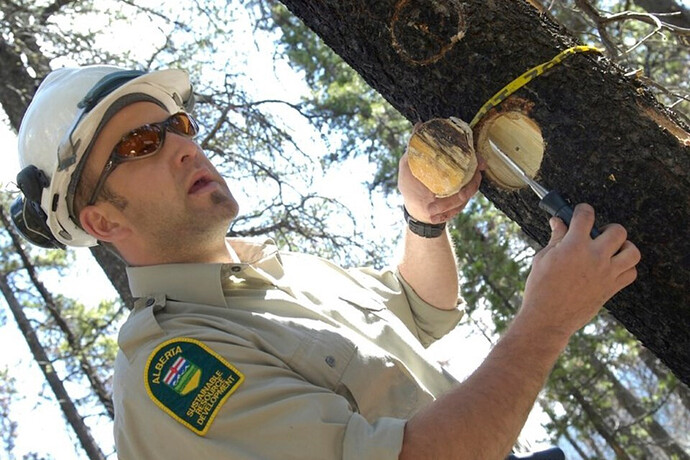By Simon Ducatel
SUNDRE – While a reportedly sharp decline in Alberta’s mountain pine beetle population is certainly a positive development for the province’s forests and economy, the general manager of Sundre Forest Products – West Fraser said neither the industry nor the government can let down their guard.
“You’re never going to get me to say clear skies ahead,” Bruce Alexander told the Albertan on Jan. 13.
“I don’t want to downplay the fact that overall, things could be a whole lot worse. The data is showing us a good news standpoint, provincially. But I don’t think we can assume that it’s behind us and we’re off to the next issue.”
Alexander was responding to questions about a provincial government press release issued late last year announcing that population surveys indicated for the fourth consecutive year a sharp decline in the number of trees killed by the bugs that are said to be the most destructive pine insects in the province.
“Beetle populations in Alberta have declined 94 per cent from their most recent peak in 2019,” reads a portion of the statement. “Sustained periods of widespread, extreme cold increased beetle mortality and have helped to limit population growth.”
Aerial surveys completed in August to identify lodgepole pine trees killed by the pests covered 6.88 million hectares, the government said, adding those monitoring efforts were focused on areas where beetle populations continue to kill trees.
“To date, more than 2.4 million hectares of Alberta forest have been affected by the spread of mountain pine beetle, killing nearly all the pine trees in the most severely affected areas.”
However, the government also tempered the positive development by recognizing the enduring looming threat of a resurging population boom in certain areas given the right conditions.
“Continued population pressure from Banff National Park, coupled with recent, relatively mild winters, mean that the Bow Valley, Kananaskis and Crowsnest Pass areas remain a priority for continued management and control.”
The insect kills pine trees by secreting a blue-stain fungi that clogs and destroys the conductive tissue of an affected tree. According to the provincial government, there are 5.5 million hectares of pine in Alberta representing a value of more than $11 billion that is susceptible to the pest.
Considering the mountain pine beetle’s devastating impact on B.C.’s forest industry and the ripple effect on their economy, Alexander was glad to see the situation in Alberta starting to come “under control naturally through weather and different circumstances that the industry and government have been taking for many years to try and help slow that population.”
Part of those strategies involve close collaboration between the forest industry and the provincial government, both of whom have programs to annually collect data, he said.
“The beetles are always on your land base; it’s just to what degree,” he said. “The populations overall are declining; the populations largely to the north of our specific area are showing some progressive decreases. But there are still active populations to the south of us.”
The unfortunate situation that unfolded in B.C. had a silver lining of offering valuable learning lessons for the industry and government in Alberta, he said, adding our western-most neighbours are still reeling from the pest’s impact.
“The sustainable cut-levels for (B.C.) have to adjust based on what your available healthy timber allotment is,” he said, adding reduced cut-levels translate to fewer employment opportunities.
Recognizing the pine beetle’s tendency to target mature trees, the Alberta government developed a healthy pine strategy with that knowledge in mind, he said.
“Forest company licensees are expected to look at their land base and have a good understanding of their lodgepole pine components and their age distributions,” explained Alexander.
“And then through that, are to focus their harvest on the older, mature pine because that’s the most susceptible risk to devastating impacts of the mountain pine beetle.”
Even at the peak of the pine beetle population boom in Alberta, the area covered under the Sundre mill’s forest management agreement (FMA) largely dodged the proverbial bullet.
“We have pockets of beetle on the FMA that we’ve been addressing through our harvest operations. But a mass attack, we have not experienced out here. We’re fortunate,” he said.
“But we’ve been sticking to provincially regulated expectations for harvest,” he said, referring to the ongoing effort to focus on selecting older pine stands to help mitigate potential outbreak risks.
Both the provincial government and the industry invest a lot of time, money and energy collaborating on developing mitigation strategies that alongside natural conditions contributed to the substantial decline in pine beetle populations, he said.
The provincial government also said in the press release that it is partnering with local and Indigenous contractors on progressing the pine beetle management plan into the next phase, “which includes control activities such as targeted, single-tree cutting and burning, whole-tree chipping and harvesting entire areas of affected pine trees as needed.”
In 2021, the average number of infested trees per site fell to about three, the lowest number since Alberta’s management program began, and a drastic drop from the 2009 all-time high of more than 18 per site, the province reported.
“It’s obviously a good news story for the whole province; not just for Sundre really, because (further spread) would be so devastating for everybody,” Alexander said.
“I think though, there’s always cautious optimism. We still need to stay vigilant in monitoring for pests, which we do whether there is an actually known outbreak of something or not.”
